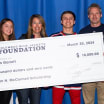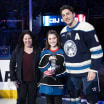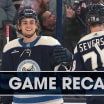About four years ago, Nick Foligno could draw you a map of his daughter Milana's heart on a blank sheet of paper.
After meeting with pediatric heart specialists at Nationwide Children's Hospital in Columbus and Boston Children's Hospital, where Milana had open-heart surgery 21 days after her birth, the Blue Jackets' captain - and wife, Janelle - became all too familiar with medical terminology associated with her condition.
Diagrams and drawings were committed to memory. Things like "bicuspid" and "mitral valve" became part of their vocabulary.
"[The doctors] were great, because they draw a lot of stuff to help you understand what's going on," said Foligno, who donated $1 million last year to fund research at both Nationwide and Boston Children's. "I'm very visual, so I literally could draw her heart. I could tell you exactly where the chambers were by the end of it. I was drawing diagrams for my family, so they could understand. It was wild. It's pretty funny how you become a pro."
Last week, the "pros" in the Foligno family took another medical course.
Under the microscope: Folignos 'humbled' by tour of lab they helped fund
Nick and Janelle Foligno enjoy first look at research facility bearing their name.
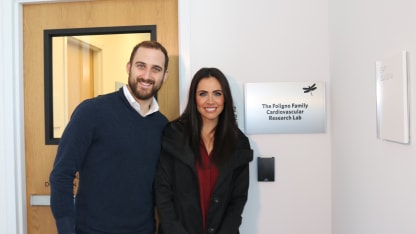
Nick and Janelle got a tour of the Foligno Family Cardiovascular Research Lab at Nationwide's Center for Cardiovascular Research, strolling along and peeking in to see how several experiments were conducted.
They peered through a microscope, literally a couple times, at how their donation will help others.
"It was an eye-opening experience," Janelle said. "We've spoken to a lot of the different doctors and the researchers, but to see firsthand the work they're doing, it's an experience that you never think you'll have. It kind of brings to light all the intense work that's being done."
The Folignos' understanding of medical jargon associated with the heart also came back. They were given explanations about some of the experiments in the lab, and left the visit with a basic understanding of each one.
"Five years ago, there's no way I would've understood anything they were saying," Foligno said. "I wouldn't have had a clue what 'bicuspid' and all those kinds of words meant. It's pretty cool now that I can understand it. Not that I'm a veteran or a professional in this stuff, but it is amazing that you really do understand the situations. You also understand there's a lot of people affected by it. There's all types of diseases and illnesses in this world, and we're so fortunate to get to do what we do and be in a position to help."
He and Janelle get a reminder every morning, when Milana begins another day of life.
According to the Centers for Disease Control, 7,200 babies are born each year with one of seven critical congenital heart defects. That works out to about 18 out of every 10,000.
Milana Foligno, whose condition was extremely rare, was one of them.
Had it not been for medical technologies already used to detect heart defects in infants, such as a Pulse Oximetry Test (Pulse Ox), her outcome might've been a lot different.
Most states do not require newborn infants to undergo a Pulse Ox screening, which determines the amount of oxygen in a baby's blood and the pulse rate. Ohio does. Low oxygen levels can be an indicator of a heart defect, which can prompt further examination by doctors.
Rates in the upper 90s to 100 percent is the normal range for infants. Milana's was much lower, which was a red flag for her doctors. They called for a pediatric echocardiogram, which revealed her particular heart defect.
"Her normal level was in the 60s when she was born, which is why it was quite alarming to them," Janelle Foligno said. "So, that's actually what was able to cause the diagnosis. Otherwise, we would've taken her home and she would've been very, very sick before we could've helped her."
Continuing to advance technology, diagnosis and treatment of heart conditions was the Folignos' ultimate goal when they decided to make their substantial contribution. Seeing that work conducted live, in person, was inspirational.
"For us, we always said that we are very fortunate with Milana's situation, having gotten her the help that she was able to get, and to get her to a really healthy place right now," Janelle said. "Not everybody is that fortunate. There are some people who are really sick, and there are a lot of babies and children that are battling every day. We feel humbled to give a small piece of the pie. We're just a small part of this. Microscopic, if we're talking lab talk. It just makes you feel good."
Nationwide's research wing also gets financial support from governmental grants, but private donations are a big boost, said Dr. John P. Cheatham, co-director of Nationwide's Heart Center.
"Nick and Janelle were looking with great foresight to the future," said Cheatham, who helped lead the tour. "They had an experience they weren't counting on with little Milana, and they wanted to take that experience and move it forward. One of the ways to do that is in the cardiovascular research area, where new technologies and new ways to treat patients with congenital heart disease are developed."
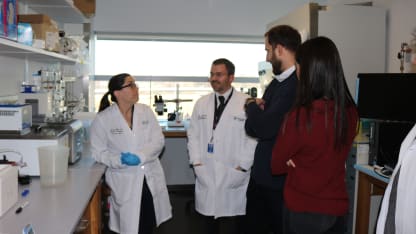
Areas of research at Nationwide Children's include heart valves, blood vessels, gene therapy and tissue engineering, all conducted by physicians, scientists, professors and student researchers.
"Their gift allows the people that are working on that the opportunity to continue with a lot of their research," Cheatham said. "One of the things we've realized here, as well as in the large children's centers, is that you have to have a research arm to do this, that has a marriage with the clinical arm. So, you take a problem, try to figure it out from a research standpoint, somehow develop that and get an answer, so you can go to the clinical arena to improve treatments. That's what this does here."
It's an extension of what allowed the Folignos to enjoy their daughter's life, watching her the past four years as she's grown and adjusted to gaining two younger brothers along the way.
"I don't think there's ever been a day where you don't think about it," Foligno said. "It's weird, just how far we've come and how thankful we are. You don't take anything for granted anymore. For your first child, you have a picture of how everything is supposed to be, and then you get a diagnosis and you throw that completely out the window."
At that point, medical jargon and charts become a lot easier to understand, thanks in large part to the experts who explain them.
"We're pretty private people, but I think we feel a duty, in a way, to share our story so people understand that these things happen to anyone," Foligno said. "Also, it's to share that there are people out here, like these [lab technicians and researchers], who are doing so much work to make a difference. This is more about these guys, and what they're doing for us, because … man, when you've been there, you're helpless and you're looking for every answer possible."





